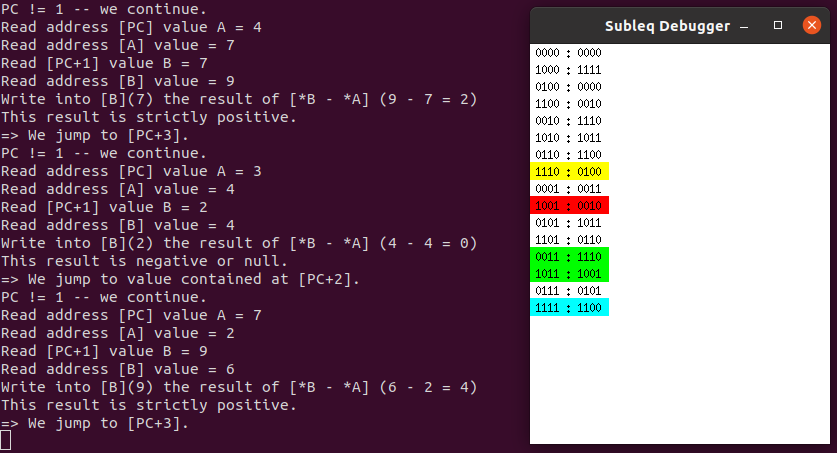Subleq

Subleq is a microprocessor implementation with a single instruction (OISC). The project also features a tool that produces RAM images whose subleq-computation doesn't loop, which we use as input tests.
High-level description of the project
The goal of the project is to implement a subleq microprocessor in bopkit. This microprocessor should be able to compute the image of a subleq program contained in its internal RAM memory.
So we can test it and run demos easily, we'll drive its execution using an external controller, which can partially be written in software. The goal of the controller is to be able to read memory files from disk, loads them into the subleq machine, wait for it to finish its computation, retrieves the subleq memory contents to save it to disk, and repeat with another file.
So it's more fun to look at, our simulation will make use of Graphics windows that show the memory cells being read and written to.
To see all the files of this project, check out the source code on GitHub.
Origin
This project was written by Mehdi Bouaziz and Mathieu Barbin in 2008, as part of a class on digital circuits with Prof. David Naccache.
Subleq
OISC stands for One Instruction Set Computer, a machine providing only one instruction. Subleq refers to a kind of OISC where the one instruction is "SUBtract and branch if Less-than or EQual to zero", conventionally abbreviated to subleq. There're multiple variants of subleq, so we'll describe the one we've used in this project here:
Let M be the RAM memory of the microprocessor, and pc (Program Counter) a
register holding the line of code of the instruction currently executed. The
subleq(pc) instruction is defined as follows:
subleq(M, pc):
a <- M[pc] // Read &a
b <- M[pc+1] // Read &b
r <- M[b] - M[a] // Compute *b minus *a
M[b] <- r // Store the result at &b
// Jump
if r <= 0 then
pc <- M[pc+2] // If r <= 0 jump to address contained in pc+2
else
pc <- pc+3 // Otherwise continue with the next 3 operands
fi
Note that this microprocessor doesn't have the traditional ROM with the code to execute, and RAM with its internally memory. Its memory contains the code! (the operands), and running the program modifies the memory, so in fact the program itself.
By convention, we stop the program if it ever reaches a state where pc=1.
Otherwise, a program loops forever.
Subleq programs may be hard to predict. We've heard somebody refer to the subleq machine as the Brainfuck of Hardware, I guess you can see why they would say that!
Simulator
The first thing we've implemented is a software program that can read a memory contents from a file, and execute it through the subleq process. This subleq simulator prints the state of the memory when the program terminates, or produces an error if it detects that the program loops.
For example, let's consider the following RAM image (architecture 4 bits):
$ cat ar4-01.input
0000
1111
0010
0010
1110
1011
1100
1001
0011
0110
1011
0110
1110
1001
0101
1100
You can invoke the simulator with this command:
$ subleq simulate --ar 4 ar4-01.input
Subleq simulator: running...
[ ;-) ] Program terminated after 9 steps. IM 15.62 % diff.
0011
1111
0000
0010
1101
1011
1100
0100
0011
0010
1011
0110
1100
1001
0101
1100
In addition to the final state of the memory, the simulator prints to stderr as a percentage how different is that final memory from its initial state (here 15.62% of the bits have changed through the subleq execution).
If a cycle was detected, the simulator would exit 1. Let's check it out on a file which we know doesn't terminate:
$ subleq simulate --ar 4 cycle01.input
Subleq simulator: running...
[ ;-( ] Cycle detected : Aborting computation.
Program does not terminate.
[1]
Debugger
To run a subleq program step by step while looking at the memory, we've
implemented a debugger mode. To run the debugger, simply add the option -g to
the command line.
$ subleq simulate --ar 4 ar4-01.input -g

Generator
For the project, we've shied away from actually attempting to write "real" subleq programs, and simply implemented a random generator to constitute a collection of tests cases. Check it out with:
$ subleq generate --help
Architecture
The project consists of 3 components:
The Disk_interface component has the ability to read and write files on disk,
while the 2 others only run computation from local memory.
Original project
In the original project, the controller and disk interface were actually run on a distant machine, and resulted from the simulated execution of a 4004 processor. More details here. Here, we're featuring a simplified version of the project that only involves bopkit circuits and OCaml programs running locally.
Sequence Diagram
For each file to process, there will be a sequence of exchanges that looks like the following:
At the end of such process, the Subleq machine is in standby, waiting for the
next file to compute.
To run a demo of this process:
$ dune build @subleq-simulation
This will open 2 Graphical windows showing the Subleq Internal memory executing the program, and the Disk_interface memory, which will show you the different parts of the process, including the exchange of memory cells, cycle by cycle, as well as the full subleq execution.
Tests
We've used our subleq image generator to produce test cases with architectures of 4 and 8 bits which we saved here.
We run a hardware simulation during which the results of the subleq process is saved to disk by the disk interface. At the end of the process we compare the resulting images against the expected outputs that have been previously computed by our subleq simulator.
For example, see: run-ar4.t